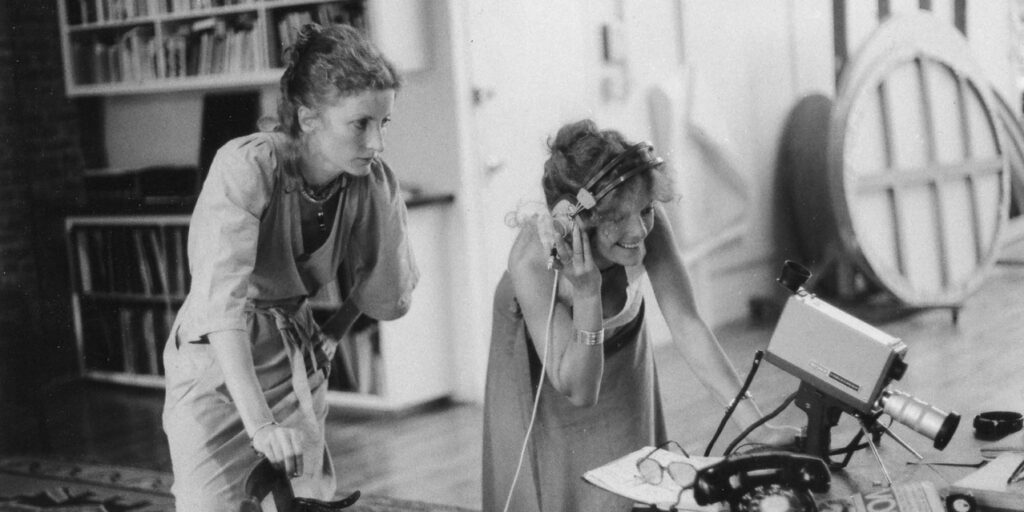DELPHINE SEYRIG, JUST ANOTHER SORCERESS

Curated by Emilie Cauquy
I was the log and the hearth. Fire too I can.
Anne Sylvestre, Une sorcière comme les autres (1975)
Delphine Seyrig was a trailblazer in every respect. Glamour icon of cinema all over the world, Seyrig turned her image inside out during the 1970s. Gone were the beautiful female effigies of Resnais, Truffaut, Demy and Buñuel. Replaced by the women of Duras, Akerman and Kermadec. This demystifying break in order to champion the feminist cause came about through her decision to play marginalised characters rarely seen on the screen and developed into the production of militant films. As an actress, producer and activist, Delphine Seyrig led an adventurous life: from theatre stages to Women’s Liberation Movement meetings via Anne Sylvestre’s title album track, Une sorcière comme les autres, and from lilac-clad fairy godmother in Peau d’âne to activist videos. As someone who didn’t hold with regular employment, she always did as she pleased.
From 1975, with Carole Roussopoulos and Ioana Wieder, Seyrig produced a series of videos under the collective name Les Insoumuses (Defiant Muses). In the searing manifesto tapes, such as Sois belle et tais-toi! (1976), SCUM Manifesto (1976), and Maso et Miso vont en bateau (1976), the lightweight video camera became a tool of emancipation and a means of political activism. In 1982, the three women set up the Centre audiovisuel Simone de Beauvoir, an unprecedented audiovisual archive of the struggles of the day – in France and elsewhere – preserving, producing and circulating an audiovisual ‘she-ritage’ as opposed to ‘he-ritage’.
Seyrig is all about creating characters: a young sophisticate or a woman in her forties, an actress or an activist. Influenced by her New York beatnik years (with Lee Strasberg, Robert Frank and Jack Kerouac), as well as the 1960s avant-garde movement, Seyrig pares down roles, tears them up and turns them inside out. In true American style, her career will be influenced by her public persona. To demystify is also to construct. Rather than say who she is, she wants to talk about what she does. She thinks aloud and was already questions the construction of the gaze: “I could get it wrong. I could believe that I’m beautiful, like women who are looked at. Because I am looked at a great deal. But I know that it isn’t a question of beauty, it’s something else. The mind, for instance. I appear however I wish to appear. I can also be beautiful if that’s what they want me to be.”
But who is she? The inimitable Duras answers: “How many pages does it take to describe a smile, a glance, an inflection of the voice? A thousand? All I can do is to make you want to imagine in your own way the woman who is Delphine Seyrig.” She’s certainly no apparition; at a pinch, she’s a visionary happening, way ahead of her time. These days, word has it that Seyrig has gone viral: Jeanne Dielman is voted the best film of all time by “Sight and Sound”, #DelphineSeyrig has 1.1 million views on TikTok. DS, still an icon, but of a different kind. After all, Antoine Doinel did say, “Thank you, sir” to Fabienne Tabard in Baisers volés.
Émilie Cauquy
Image credit: Archives Familles Seyrig et Roussopoulos / Centre audiovisuel Simone de Beauvoir (Seyrig and Roussopoulos’ families archives / Centre audiovisuel Simone de Beauvoir)
Program
Saturday 22/06/2024
14:30
Cinema Lumiere - Sala Scorsese
BAISERS VOLÉS
BAISERS VOLÉS
Émilie Cauquy (La Cinémathèque française)
Sunday 23/06/2024
09:00
Cinema Lumiere - Sala Scorsese
SOIS BELLE ET TAIS-TOI!
SOIS BELLE ET TAIS-TOI!
Introduction curated by Il Cinema Ritrovato Young
Sunday 23/06/2024
16:30
Arlecchino Cinema
GOLDEN EIGHTIES
GOLDEN EIGHTIES
Tomas Leyers (Cinematek)
Monday 24/06/2024
14:15
Cinema Lumiere - Sala Scorsese
LES LÈVRES ROUGES
LES LÈVRES ROUGES
Harry Kümel.
Tuesday 25/06/2024
09:00
Cinema Lumiere - Sala Scorsese
GOLDEN EIGHTIES
GOLDEN EIGHTIES
Wednesday 26/06/2024
17:45
Auditorium DAMSLab
SOIS BELLE ET TAIS-TOI!
SOIS BELLE ET TAIS-TOI!
Babette Mangolte e Émilie Cauquy.
Thursday 27/06/2024
09:00
Cinema Lumiere - Sala Scorsese
LES LÈVRES ROUGES
LES LÈVRES ROUGES
Friday 28/06/2024
14:15
Cinema Lumiere - Sala Scorsese
CALAMITY JANE ET DELPHINE SEYRIG: A STORY
CALAMITY JANE ET DELPHINE SEYRIG: A STORY
Babette Mangolte


